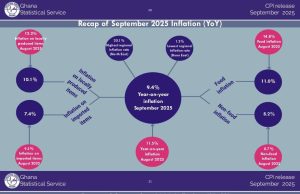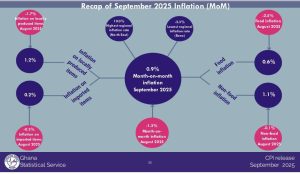
By Juliet ETEFE ([email protected])
Headline inflation has slowed to 9.4 percent in September 2025, marking the country’s first return to single-digit inflation in four years and reinforcing signs of stabilisation in the economy.
The latest data released by the Ghana Statistical Service (GSS) shows a sustained downward trend, with September marking the ninth consecutive month of decline in headline inflation.
According to the Government Statistician, Prof. Alhassan Iddrisu, the figures confirm that the country has firmly reversed the inflationary pressures that dominated much of the past three years.
“On average, prices of goods and services in September were 9.4 percent higher than the same period last year, the lowest since August 2021,” he explained.
However, he cautioned that although the year-on-year numbers look positive, households still felt a marginal increase of 0.9 percent month-on-month between August and September 2025.

Food and non-food dynamics
Food inflation fell to 11.0 percent in September, down from 14.8 percent in August. On a month-to-month basis, food prices rose by 0.6 percent, suggesting that while the pace of increases is slowing, food remains a sensitive driver of household expenditure.
Non-food inflation eased to 8.2 percent compared with 8.7 percent in August. However, non-food items recorded a slightly higher month-to-month increase of 1.1 percent.
Breaking it further down, inflation for goods slowed to 11.2 percent from 13.9 percent in August, while services inflation eased to 4.8 percent from 5.4 percent.
Since goods account for nearly three-quarters of the CPI basket, the slowdown here provides the most immediate relief to consumers.

Local vs. imported prices
The data also revealed contrasting trends between local and imported inflation. Locally produced items remain more expensive despite easing pressures, with inflation falling to 10.1 percent in September from 12.2 percent in August. In contrast, imported inflation dropped more sharply to 7.4 percent, down from 9.5 percent.
The relative strength of the cedi, alongside softer global commodity prices, is credited with helping moderate import prices. Meanwhile, persistent supply and distribution challenges continue to weigh on domestically produced goods.
Regional disparities
Despite the overall national decline, inflation remained uneven across the regions. North East region recorded the highest rate at 20.1 percent, highlighting continued cost pressures in food and transport. At the other end, Bono East registered the lowest inflation at just 1.2 percent, reflecting better price stability.
These sharp disparities underscore the role of local supply chains, transport costs, and market access in shaping the inflation experience across the country.
Recommendations
In its advisory, the GSS urged households to take advantage of the declining inflation by budgeting smarter, avoiding unnecessary spending, and setting aside savings.
Businesses were encouraged to invest in efficiency and local sourcing, cut waste, and pass on cost savings to consumers to strengthen competitiveness.
For the government, the key recommendation is to maintain fiscal discipline while focusing resources on keeping food prices stable through improved storage, irrigation, and transport systems. Tackling persistent regional disparities was also flagged as a priority.
The post Inflation returns to single digit at 9.4% in September, first since 2021 appeared first on The Business & Financial Times.
Read Full Story


















Facebook
Twitter
Pinterest
Instagram
Google+
YouTube
LinkedIn
RSS